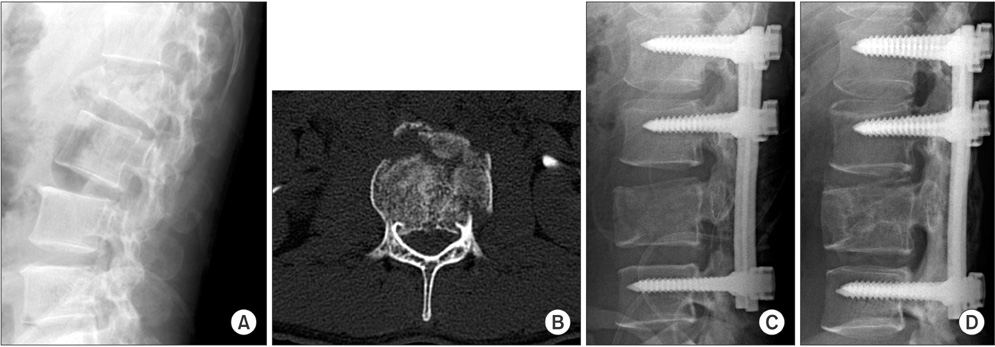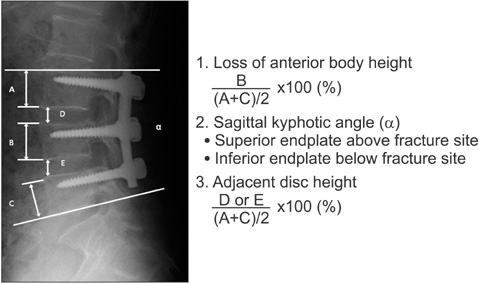Clin Orthop Surg.
2016 Mar;8(1):71-77. 10.4055/cios.2016.8.1.71.
More than 5-Year Follow-up Results of Two-Level and Three-Level Posterior Fixations of Thoracolumbar Burst Fractures with Load-Sharing Scores of Seven and Eight Points
- Affiliations
-
- 1Department of Orthopedic Surgery, Bundang Jesaeng General Hospital, Daejin Medical Center, Seongnam, Korea. hynaspin@naver.com
- KMID: 2363948
- DOI: http://doi.org/10.4055/cios.2016.8.1.71
Abstract
- BACKGROUND
The development of pedicle screw-based posterior spinal instrumentation is recognized as one of the major surgical treatment methods for thoracolumbar burst fractures. However, the appropriate level in posterior segment instrumentation is still a point of debate. To assesses the long-term results of two-level and three-level posterior fixations of thoracolumbar burst fractures that have load-sharing scores of 7 and 8 points.
METHODS
From January 1998 to May 2009, we retrospectively analyzed clinical and radiologic outcomes of 45 patients with thoracolumbar burst fractures of 7 and 8 points in load-sharing classification who were operated on using two-level posterior fixation (one segment above and one segment below: 28 patients, group I) or three-level posterior fixation (two segments above and one segment below: 17 patients, group II). Clinical results included the grade of the fracture using the Frankel classification, and the visual analog score was used to evaluate pain before surgery, immediately after surgery, and during follow-up period. We also evaluated pain and work status at the final follow-up using the Denis pain scale.
RESULTS
In all cases, non-union or loosening of implants was not observed. There were two screw breakages in two-level posterior fixation group, but bony union was obtained at the final follow-up. There were no significant differences in loss of anterior vertebral body height, correction loss, or change in adjacent discs. Also, in clinical evaluation, there was no significant difference in the neurological deficit of any patient during the follow-up period.
CONCLUSIONS
In our study, two-level posterior fixation could be used successfully in selected cases of thoracolumbar burst fractures of 7 and 8 points in the load-sharing classification.
Keyword
MeSH Terms
-
Adult
Back Pain
Female
Follow-Up Studies
Fracture Fixation, Internal/adverse effects/instrumentation/methods/*statistics & numerical data
Humans
Lumbar Vertebrae/*injuries/physiopathology/*surgery
Male
Middle Aged
Pedicle Screws
Postoperative Complications
Retrospective Studies
Spinal Fractures/physiopathology/*surgery
Thoracic Vertebrae/*injuries/physiopathology/*surgery
Treatment Outcome
Figure
Reference
-
1. Lee CS, Chung SS, Jung HW, Kim ES. Decision of posterior fixation level by load-sharing classification in thoracolumbar and lumbar burst fracture. J Korean Soc Spine Surg. 2001; 8(1):27–38.
Article2. Parker JW, Lane JR, Karaikovic EE, Gaines RW. Successful short-segment instrumentation and fusion for thoracolumbar spine fractures: a consecutive 41/2-year series. Spine (Phila Pa 1976). 2000; 25(9):1157–1170.
Article3. Lee KY, Sohn SK, Kim CH, Song CK. Posterior short-segment instrumentation of thoracic and lumbar bursting fractures: retrospective study related with load-sharing classification. J Korean Soc Spine Surg. 2001; 8(4):497–503.
Article4. Denis F. The three column spine and its significance in the classification of acute thoracolumbar spinal injuries. Spine (Phila Pa 1976). 1983; 8(8):817–831.
Article5. McCormack T, Karaikovic E, Gaines RW. The load sharing classification of spine fractures. Spine (Phila Pa 1976). 1994; 19(15):1741–1744.
Article6. McLain RF, Sparling E, Benson DR. Early failure of short-segment pedicle instrumentation for thoracolumbar fractures: a preliminary report. J Bone Joint Surg Am. 1993; 75(2):162–167.
Article7. Kim CH, Hwang JK, Choi YJ, Kim KH, Song JS, Kang JH. Treatment of thoraco-lumbar bursting fractures according to load-sharing classification. J Korean Fract Soc. 2005; 18(1):69–75.
Article8. Altay M, Ozkurt B, Aktekin CN, Ozturk AM, Dogan O, Tabak AY. Treatment of unstable thoracolumbar junction burst fractures with short- or long-segment posterior fixation in magerl type a fractures. Eur Spine J. 2007; 16(8):1145–1155.
Article9. Anekstein Y, Brosh T, Mirovsky Y. Intermediate screws in short segment pedicular fixation for thoracic and lumbar fractures: a biomechanical study. J Spinal Disord Tech. 2007; 20(1):72–77.
Article10. Dick JC, Jones MP, Zdeblick TA, Kunz DN, Horton WC. A biomechanical comparison evaluating the use of intermediate screws and cross-linkage in lumbar pedicle fixation. J Spinal Disord. 1994; 7(5):402–407.
Article11. Guven O, Kocaoglu B, Bezer M, Aydin N, Nalbantoglu U. The use of screw at the fracture level in the treatment of thoracolumbar burst fractures. J Spinal Disord Tech. 2009; 22(6):417–421.
Article12. Chung JY, Rhym IS. Short segment transpedicular Cotrel-Dubousset instrumentation including involved vertebra for fractures of thoracic and lumbar spine. J Korean Orthop Assoc. 1994; 29(3):940–948.
Article13. Jeong ST, Cho SH, Song HR, Koo KH, Park HB, Chung UH. Comparison of short and long-segment fusion in thoracic and lumbar fractures. J Korean Soc Spine Surg. 1999; 6(1):73–80.14. Mahar A, Kim C, Wedemeyer M, et al. Short-segment fixation of lumbar burst fractures using pedicle fixation at the level of the fracture. Spine (Phila Pa 1976). 2007; 32(14):1503–1507.
Article15. Kanna RM, Shetty AP, Rajasekaran S. Posterior fixation including the fractured vertebra for severe unstable thoracolumbar fractures. Spine J. 2015; 15(2):256–264.
Article
- Full Text Links
- Actions
-
Cited
- CITED
-
- Close
- Share
- Similar articles
-
- Comparison of Short Segment and Long Segment Posterior Instrumentation of Thoracolumbar and Lumbar Bursting Fractures at Load Sharing Score 7 or Above
- Decision of Posterior Fixation Level by Load-Sharing Classification in Thoracolumbar and Lumbar Burst Fracture
- The Outcomes of Short and Long Segment Posterior Instrumentation of Thoracolumbar Burst Fractures with a Load Sharing Score of 7 or More
- Radiological Outcome of Short Segment Posterior Instrumentation and Fusion for Thoracolumbar Burst Fractures
- Relationships Between Canal Occlusion and Neurologic Deficits, and Between Kyphotic Deformities and Fracture Types in Unstable Thoracolumbar Burst Fractures





